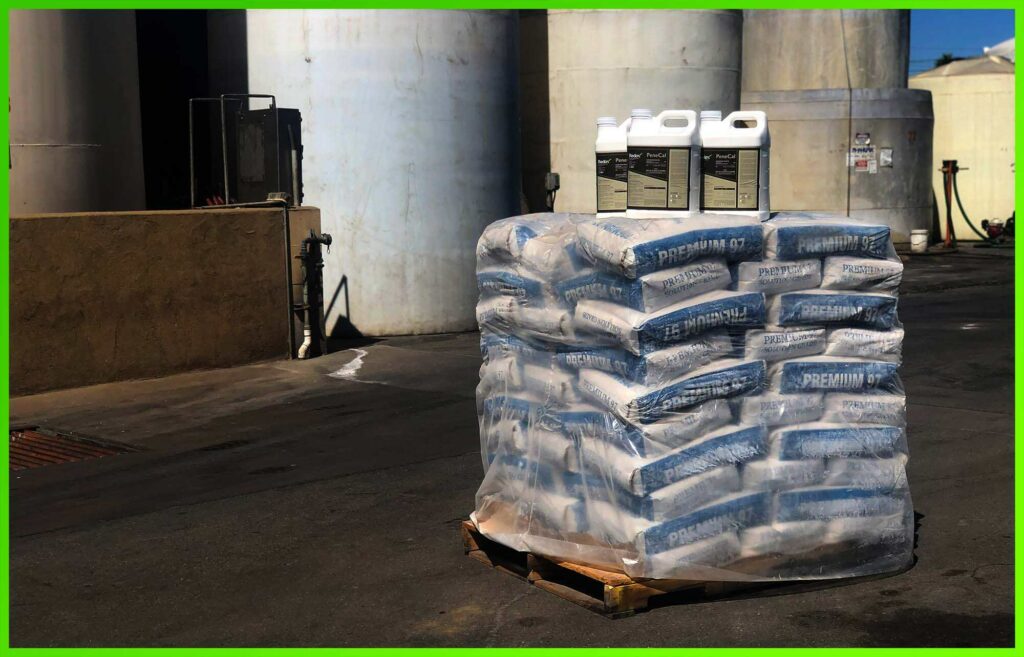Gypsum has been used in agriculture as a soil amendment for centuries. With new technologies entering the fertility market every year, gypsum still has a place, but that “fit” is severely constrained. This blog will discuss agronomic fits for which gypsum has been the traditional recommendation and new technologies that have come to market that deliver better agronomic results.
Gypsum broadly refers to the compound calcium sulfate. There are two forms of calcium sulfate: anhydrite meaning ‘without water’ and dihydrate meaning ‘with two waters’. In addition to form, there is also purity or grade which refers to how much calcium sulfate is in the “Gypsum” product with 95% being purer then say a 50% gypsum. For the purposes of this discussion, we will use the term gypsum to refer to a high grade dihydrate material.
For more info on gypsum check out this link.
There are many reasons to apply calcium to a crop that range from root growth to crop quality. The key steps to influence calcium in the crop are calcium availability, calcium application timing, and calcium plant uptake. The calcium applied must be present in soil when the crop needs it and must be in a form that the plant can take up, that is plant available.
Gypsum, being a calcium containing mineral, is a tempting choice on paper for calcium nutrition. In most cases it is the cheapest way to buy units of calcium for a crop. Unfortunately, those calcium units are not very available to the crop as gypsum has very low solubility. With clean water it takes about 100 gallons to dissolve 1.5 pounds of gypsum. Calcium nitrate, for comparison, has a solubility in water at room temperature of about 1,000 pounds per 100 gallons of water.
To overcome these challenges Mainstay™ Microencapsulation technology was brought to the market. Mainstay™ Microencapsulation technology is the fusion of a mineral ion within a proprietary surfactant formulation to reduce negative soil chemical reactions. This technology is exemplified with Mainstay™ Calcium and O-X Mainstay™ Calcium (Organic). Both Mainstay™ products are liquid 20% calcium products allowing for easy application through sprayers or irrigation systems. The calcium that is contained in Mainstay™ Calcium and O-X Mainstay™ Calcium remains plant available in the soil and does not tie up with phosphate or other anions. This allows for efficient application rates and a predictable crop response. Furthermore, it can be applied during times of peak calcium need by the crop as it is immediately available to the crop for uptake and can be applied through standard application techniques.
Water movement in soils is important to deliver oxygen and other nutrient to crop roots, leach salts, and prevent stagnation from poor drainage. Water surface tension is a key factor in how water moves in soil.
The way in which water penetrates a soil is described by water surface tension. Water surface tension is naturally influenced through water chemistry, specifically dissolved cations. Cations such as calcium, magnesium, sodium, and potassium, can be found in most irrigation water and the ratio of these to one another influences water surface tension. Specifically, water that has a calcium to magnesium + sodium ratio of 2:1 or greater tends to penetrate soil better (Note: cation comparisons are represented in milliequivalent per liter units).
Ok, so that’s the hard chemistry. Now, how does gypsum fit into this discussion? Traditionally, gypsum is used to add more calcium into water and thus move the calcium ratio up. Remember, however, that gypsum has a relatively low solubility and can add about 0.35 pounds of dissolved calcium per 100 gallons of water (23% Ca x 1.5 lb Gypsum per 100 gallons of water) which is about 21 meq/l on paper. However, when we adjust for gypsum grade, particle size, budget, and water quality, gypsum may not move the cation ratio enough to make a difference in field water moment. For water that is very clean, such as snow or rain fed irrigation water, gypsum can be used to “dirty the water” and improve water infiltration somewhat but it is still common to see poor infiltration even when gypsum is applied at the appropriate rate.
To achieve proper water surface tension to maximize soil water movement to the root zone a departure from traditional cation-based water chemistry is needed. Surfactant technologies have been used in many parts of agriculture for decades. A surfactant is a product that modifies the interfacial tension properties of the solution it is in. Interestingly, surfactant is actually a shortening of the phrase ‘Surface Active Agent’ coined in the 1950s. There are hundreds of synthetic and naturally derived surfactants on the market, each with its own properties. It is also common to blend surfactants to achieve a desired result. PeneCal™ is a surfactant based technology that is unique in the ag market for its long lasting impact on soil water movement and the 10% calcium content that utilizes Mainstay™ Microencapsulation Technology to maximize results. PeneCal™ has been documented to outperform gypsum systems in helping increase water movement in the soil (See Redox Result Here)
Surfactants do not depend on water cation ratios to achieve their results, so products like PeneCal™ are effective across a broad range of water chemistries and regions.

Gypsum can be an appropriate input where the calcium can improve water penetration and where the crop will benefit from sulfate-sulfur nutrition. Additionally, when application costs are generally low. Calcium can also be delivered to the crop by the technologies discussed above. Sulfate can come from other sources as well, such as potassium sulfate, ammonium sulfate, and other sulfate-based micro and macro nutrients. If you do decide to use gypsum, be sure to consider the product grade, dihydrate vs. anhydrate, application costs, predicted crop response, appropriate application timing, and, of course, alternative strategies on the market.
Questions? Want to know more about Gypsum in the Modern Market?
Subscribe to receive our Redox Bio-Nutrients updates